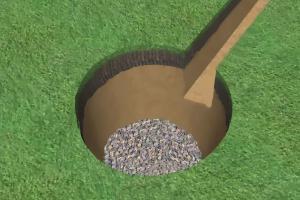Mastering the Art of Dry Well Construction: A Comprehensive Guide

-
Quick Links:
- 1. Introduction
- 2. What is a Dry Well?
- 3. Benefits of Building a Dry Well
- 4. Planning Your Dry Well
- 5. Materials Required
- 6. Step-by-Step Guide to Building a Dry Well
- 7. Case Studies
- 8. Expert Insights
- 9. Maintaining Your Dry Well
- 10. FAQs
1. Introduction
Building a dry well is an excellent way to manage excess water in your yard while promoting environmental sustainability. This comprehensive guide will walk you through the process of constructing a dry well, from understanding its purpose to maintaining it effectively.
2. What is a Dry Well?
A dry well is a subsurface structure designed to collect and disperse stormwater runoff. It typically consists of a pit filled with gravel or other permeable materials that allow water to filter through and recharge the groundwater supply.
3. Benefits of Building a Dry Well
- Efficient Water Management: Mitigates flooding and ponding in yards.
- Groundwater Recharge: Helps replenish local aquifers.
- Environmental Impact: Reduces erosion and sediment runoff.
- Cost-Effective: A DIY solution that can save money on drainage systems.
4. Planning Your Dry Well
Before embarking on your dry well project, consider the following:
- Evaluate the area for drainage issues.
- Check local regulations regarding stormwater management.
- Identify the location away from structures and utilities.
5. Materials Required
To build your dry well, you will need:
- Excavation tools (shovel, pickaxe)
- Gravel or crushed stone
- Drainage pipe
- Landscape fabric
- Concrete or plastic dry well container (optional)
6. Step-by-Step Guide to Building a Dry Well
Follow these steps to construct your dry well:
- Choose a Location: Find an area in your yard that collects excess water.
- Excavate the Site: Dig a hole that is approximately 3-4 feet deep and 3-4 feet wide.
- Install Drainage Pipe: Position the drainage pipe leading into the hole.
- Layer the Bottom: Add a layer of gravel at the bottom of the hole.
- Fill the Well: Fill the remaining space with gravel, leaving some room at the top.
- Cover with Landscape Fabric: Lay landscape fabric over the gravel to prevent soil from entering.
- Fill with Soil: Cover the fabric with soil to blend it into the landscape.
7. Case Studies
To illustrate the effectiveness of dry wells, consider the following examples:
- Case Study 1: A homeowner in Seattle, Washington saw a significant drop in yard flooding after installing a dry well, reducing the need for expensive drainage solutions.
- Case Study 2: A community park in Austin, Texas implemented dry wells and reported improved water quality in nearby ponds.
8. Expert Insights
Experts recommend considering the following when building a dry well:
- Consult with local environmental agencies to ensure compliance with regulations.
- Incorporate native plants around the dry well to enhance absorption.
9. Maintaining Your Dry Well
Regular maintenance is essential for optimal performance:
- Inspect the dry well yearly for debris.
- Remove sediment buildup and ensure drainage pipes are clear.
- Monitor surrounding vegetation for signs of overwatering.
10. FAQs
What is the best location for a dry well?
The ideal location is away from foundations and utility lines, preferably in a low-lying area where water naturally collects.
How deep should a dry well be?
A dry well should be around 3-4 feet deep, depending on the amount of water you want to manage and the geology of your site.
Can I build a dry well myself?
Yes, with the right tools and materials, building a dry well is a manageable DIY project.
What materials do I need for a dry well?
You will need gravel, a drainage pipe, landscape fabric, and tools for excavation.
How often should I maintain my dry well?
It is recommended to inspect the dry well at least once a year and after heavy rainfall.
Are there any permits required to build a dry well?
Check with your local government, as regulations vary by location regarding stormwater management.
Will a dry well attract mosquitoes?
If properly constructed and maintained, a dry well should not hold standing water and thus will not attract mosquitoes.
Can I connect multiple downspouts to one dry well?
Yes, multiple downspouts can be directed to a single dry well, but ensure adequate capacity for the water flow.
How does a dry well affect groundwater?
A dry well allows water to percolate back into the groundwater system, thus helping to recharge aquifers.
Is a dry well a permanent solution?
With proper maintenance, a dry well can be a long-term solution for managing stormwater.
For further reading, consider these authoritative sources:
Random Reads
- How to power two speakers with one channel amp
- How to make your own custom pokemon card
- How to open and edit pdf in microsoft word
- How to put closet door back on track
- How to show hidden files and folders on a mac
- How to shorten google maps urls
- How to use chemical drain cleaner
- How to stop unwanted phone calls
- How to paint varnished cupboards
- How to paint over silicone caulk